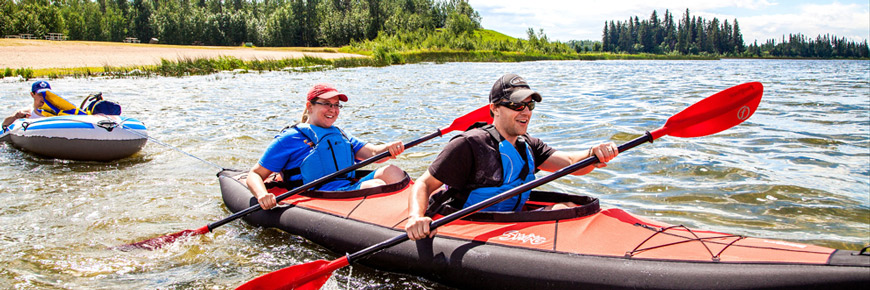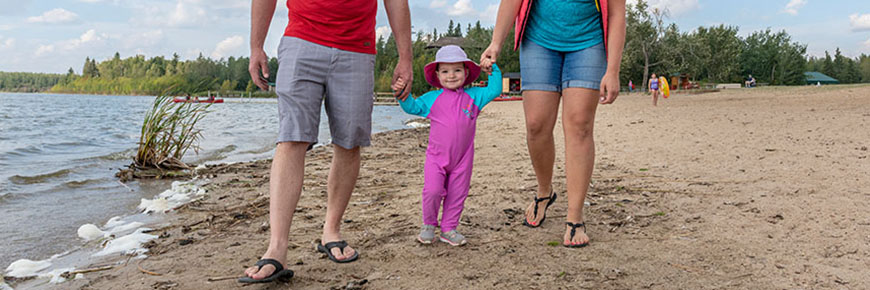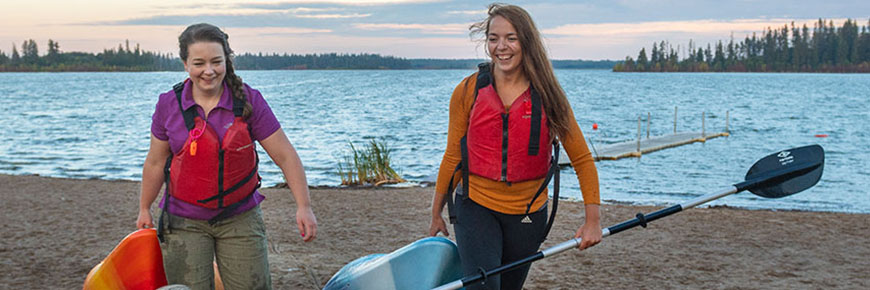
Water safety
Elk Island National Park
Swimming

Astotin Lake’s beach is a popular spot to cool off on a hot summer day. Like many public beaches and recreation areas, there are no lifeguards on duty at Elk Island National Park. Swimming skills and approved personal floatation devices (PFDs) are not always enough to save a life. Often drowning incidents involve other factors beyond swimming ability. Water safety awareness - such as how to prepare for an emergency, and what to do if one occurs - helps prevent an emergency in or on the water.
Children and weak swimmers need constant supervision in and around water. Even someone who knows how to swim are at risk for drowning. All children and weak swimmers need to be supervised in the water. When swimming, be aware of the following:
- Children and weak swimmers are encouraged to wear a certified life jacket or personal flotation device (PFD)
- Keep children and weak swimmers within arm’s reach of an adult
- Lakes or ponds might be shallow near the bank, and can suddenly increase in depth
- Wear foot protection such as aqua socks or water shoes as hazards may be present in the water
- Watch out for weeds and grass that can entangle a leg or arm
- Unlike the calm waters of a swimming pool, the beach may have hazards such as strong wind, waves and sharp rocks
- Keep off and out of the water when there is lightning
- For more information on child safety in and around water, visit the Canadian Red Cross
Be aware of “swimmer’s itch”. It appears as a skin rash caused by parasites. To prevent swimmers itch, limit time in the water and rinse thoroughly with fresh water after swimming in the lake. A fresh water shower is located close to the main beach in the Astotin Lake Recreation Area.
Like many lakes in Alberta, Astotin Lake experiences periodic blooms of blue-green algae. Blue-green algae are naturally occurring organisms found in shallow, muddy-bottomed lakes. Some forms of blue-green algae can be toxic if ingested. Watch for important bulletins and signs posted around the main beach in the Astotin Lake Recreation Area.
More swimming safety tips:
Wind-powered vessels and paddling

Paddling on Astotin Lake creates some of the most beautiful and peaceful experiences at Elk Island National Park. Plan ahead to make the most of each water adventure. Transport Canada’s Safe Boating Guide (PDF 4.7 MB) is a perfect place to start.
- Parks Canada strongly recommends that a certified life jacket or personal flotation device (PFD) be worn when recreating on any water body
- Stay close to shore and use pleasure crafts at own risk as beaches and open water are not patrolled
- Be self-reliant and prepare to self-rescue should any boat, canoe or kayak capsizes as help may not be immediately available. This includes wearing an approved life jacket or personal floatation device (PFD)
The lakes at Elk Island National Park are typically cold. Water temperature seldom rises above 15 C and hypothermia happens very quickly, even in water that seems warm. Dress in warm layers and wear waterproof clothing to prevent hypothermia. Watch for symptoms including shivering, confusion, slurred speech, drowsiness, low energy. If symptoms of hypothermia are felt, go indoors and change into warm, dry clothing. Wrap up in a warm blanket and drink a sugary beverage like hot chocolate, pop or juice (not alcohol or hot coffee). Seek medical attention as soon as possible.
More paddling safety tips:
Help prevent aquatic invasive species and whirling disease from entering Alberta waterways.
Clean, drain and dry your watercraft. Boats that have been in waters outside Alberta in the last 30 days must undergo a provincial watercraft inspection. Call 1-855-336-BOAT (2628) for further information on obtaining a boat inspection.
Emergencies:
- Call Parks Canada Dispatch 1-877-852-3100 for incidents involving wildlife, campground disturbances, wildfire, poaching or search & rescue. Response times may vary.
- In case of an emergency, call 911
- Hospitals are located in Lamont and Fort Saskatchewan
Importing, possessing, transporting, releasing or engaging in an activity that may release aquatic invasive species is prohibited and subject to fines upwards of $100 000 under the Federal Fisheries Act.
Exploring the open water of Astotin Lake is an invigorating experience when done safely. Escape the busy beach and make the most of every water adventure by carrying essential safety equipment as required by Transport Canada, including an approved life jacket or personal flotation device (PFD).
Safety is a shared responsibility. Take the following steps to ensure each adventure on the lake is a safe one:
- Parks Canada strongly recommends that a certified life jacket or personal flotation device (PFD) be worn when recreating on any water body.
- Stay close to shore and use pleasure crafts at own risk as beaches and open water are not patrolled.
- Be self-reliant and prepare to self-rescue should any boat, canoe or kayak capsize as help may not be immediately available. This includes wearing an approved life jacket or personal floatation device (PFD).
- Cellular telephone coverage varies and may not be available in all areas of Elk Island National Park.
- Complete a pre-departure checklist and take a boating safety course to learn how to avoid potential dangers and operate pleasure crafts safely.
- File a trip plan with a trusted adult and become familiar with equipment to help prevent a minor issue from becoming a life-threatening situation.
- Prepare for potentially strong winds and waves on lakes as weather can change quickly. Check forecasted weather conditions before departure.
*There is no motorised access on any water bodies in Elk Island National Park, including Astotin Lake*
Swimmer's itch
What is Swimmer's itch? "Swimmers itch" or "water rash" is the name given to a temporary skin irritation acquired by swimmers.
- Date modified :